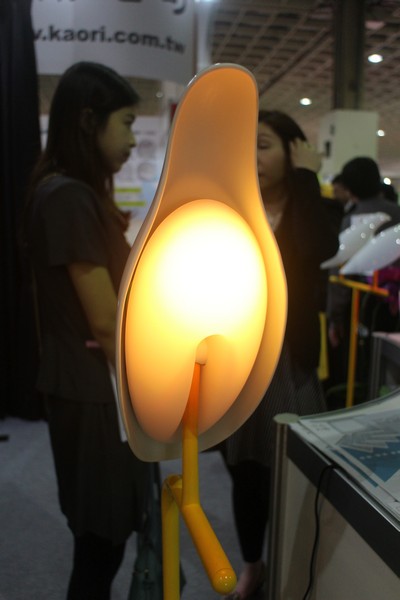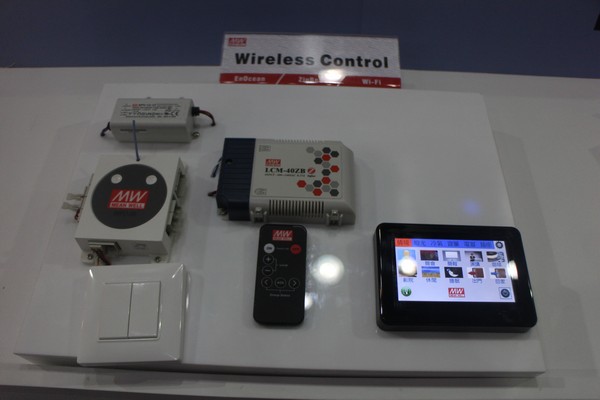(Author: Judy Lin, Chief Editor, LEDinside)
Several notable trends LEDinside observed at Taiwan International Lighting Show (TILS) 2016, which took place at Nangang Exhibition Hall from April 12-16, 2016 in Taipei, was more manufacturers showcasing filament
LED bulbs, smart lighting products, and an emphasis on reducing glare in luminaire designs.
 |
|
Epistar showcased its different LED filaments at TILS 2016, such as this bulb seen here. (All photos courtesy of LEDinside) |
LED filaments gaining traction at show
Starting off with filament LED bulbs, Epistar showcased its comprehensive range of LED filament products in hopes of bringing to attention the issue of intellectual property, said Anna Chang, Superior Administrator, Marketing Center, Epistar. The company is also in the process of considering to license its LED filaments to other bulb manufacturers this year. Several companies including Forest Lighting and OasisTek showcased LED filament bulbs employing Epistar’s LED filaments at TILS 2016.
 |
 |
 |
|
Top: Epistar's LED filaments showcased at TILS 2016. Center: Forest Lighting's LED filament bulb using Epistar LED filaments. Bottom: OasisTek's LED filament bulbs using Epistar's LED filaments. |
In addition, Epistar also showcased its IR LED proximity sensor that is capable of detecting hand movement, and change images on a screen. The related software was in-house developed by Epistar, according to Chang.
 |
 |
|
Top and bottom: Epistar's IR LED for proximity sensor applications. |
Rise of smart residential LED lights
LEDinside observed more manufacturers were releasing smart
LED lighting products at this year’s show, many of them were wirelessly controlled with Bluetooth, WIFI or with IR remote. A couple of companies also released touch sensor light switches, including Panasonic and Goldenway. LED driver manufacturer Meanwell also highlighted its solutions for smart LED applications.
 |
|
Panasonic's smart energy management system can integrate lights, air condition, and surveillance systems using WIFi, the energy management platform displayed on the TV screen as seen in the picture was turned off. The system currently is only compatible with Panasonic electronic appliances. |
Panasonic’s smart LED lighting concept went beyond lighting and into smart home power management, one of the products it showcased highlighted a WIFI based system used for managing different appliances including surveillance cameras, air conditions, and lights. The integrated electronic appliance management software was developed in Taiwan, and at this stage is incompatible with other consumer electronic brands, limiting the application to Panasonic products. The company is collaborating with local construction companies to install the products into new homes.
 |
 |
|
Top: Panasonic’s Smart Lite Touch system touch sensor embedded light switch. Bottom: LED downlight controlled by the wired light system. |
Both Panasonic and Goldenway released a smart LED light controlled using a touch sensor embedded light switch. Panasonic’s Smart Lite Touch system is still a wired system, while Goldenway’s luminaire design for commercial lighting has moved to a wireless system. The smart OL-747 troffer lights can be controlled using DALI or Zigbee communication protocols for the 140 lm/W luminaire. Many other companies displayed similar residential lighting concept products.
 |
 |
 |
 |
|
Top two photos: Panasonic's residential LED ceiling lights that use light guide designs, that can be switched to warm white and cool white. This LED ceiling light is mostly controlled using IR remote controls. Bottom two photos: Goldenway's wireless smart office troffers, OL-747, which can be controlled wirelessly with Zigbee, Bluetooth or DALI based systems.The light switch is also a touch sensor embedded switch. |
More interesting smart lighting designs included Kaori’s dove shaped luminaire that is targeting lighting designers in Taiwan, a touch sensor in the center of the luminaire enables the light to switch to different colors. The light can be tilted to different angles manually. The light currently cannot be controlled wirelessly, nor can the color pattern be programmed, but the company hopes to sell the product in the high end market and was being sold at a discount price of NT $7,800 (US $241.87) at the show.
 |
 |
 |
|
Different models of Kaori's smart LED lights that resemble doves. The bottom two photos are the same model under different color modes, and were being retailed for a discount price of NT$7,800 at the show. |
Responding to the rise of smart lighting products, Meanwell has especially showcased smart lighting solutions it has collaborated with partners to develop, such as IR remote controlled smart LED strip lights and others. The renowned driver company does not design the IC module to go with the smart lighting control, and is still mostly focused on designing drivers meet smart lighting demands.
 |
 |
 |
 |
|
Meanwell's various smart LED lighting solutions including dimmable, wireless, and IR remote controlled smart LED strip lights. |
Innovative glare reducing designs
A trend LEDinside observed at the show this year was most companies were starting to pay attention to glare, a couple companies also started to design products that effectively eliminated flicker. Seiwa for instance displayed flicker-free explosion proof
LED tube lights, and the light distribution of the lights was uniform without causing any discomfort to the eyes. According to a Lextar company representative, new lighting standards in the U.S. are now requiring lighting companies to reduce LED flicker to less than 10% in luminaire products, which might explain why some companies are starting to invest more in reducing flicker.
 |
 |
 |
|
Seiwa's explosion proof LED lights had excellent light quality with no flicker or glare issues. Top: Seiwa LED explosive luminaire. Bottom two photos: Seiwa's explosive proof LED tube light. The tube light can be removed and replaced very easily. |
Kaori, a Taiwanese LED manufacturer showcased a glare and flicker reducing LED troffers that had a design concept different from most companies. Most companies approach to reduce glare or flicker is working on the luminaire shell or casing, such as using PCB materials. Others might use PCB light guide boards inside the luminaire to diffuse or direct light, but Kaori troffers uses reflective secondary optic designs to solve the issue. Light beams are directed upwards towards the interior of the luminaire before reflecting the light downwards. Since the troffer needs space to effectively reflect the lights, the luminaire is thicker than average lights.
 |
 |
|
Kaori's LED troffer lights attracted a lot of attention from visitor. The lights use a reflective design concept that directs the light through a filter and secondary optic design before directing it downwards. The etchings on the glass cover are not used for reducing glare, and mostly just for decoration, said company representatives. |
The company showcased its patent protected 60W and 120W LED luminaires at the show, which offer color temperatures ranging from 2,700K to 6,500K. In terms of color rendering performance the troffer light offers both CRI 70 and CRI 80 options. Many visitors at the booth showed an interest in their product.
 |
|
Oasistek displayed real fruits at its booth to showcase the lighting quality of its new LED luminaires that are focused on color performance. |
OasisTek puts emphasis on color quality
OasisTek's booth featured lights for food, museum and other lighting applications. The company emphasis was on red enhancing lights, and showcased the LED downlights, recessed spotlights in various applications. Most of the company's products had a CRI of at least 80, and mostly uses LED chips from Taiwanese manufacturers such as Epistar for their products. Color temperatures for most of the products on display was 3,000K.
 |
 |
 |
|
Oasistek booth focused on various different applications where its LED lights could bring out the red in products. Top: Oasistek LED lights for retail applications. Center: Oasistek LED spotlights for painting and museum applications. Bottom: Oasistek LED tracklights that bring out the red of the bowl shown on the table. |
In short, most LED luminaire designs at this year’s show were focused on retro LED filament bulbs, glare reducing lights and smart lighting products at TILS 2016. Most luminaire manufacturers are becoming more aware to the need to reduce glare and flicker in products, especially those that might be shipping products to regional markets with specific demands. More manufacturers are starting to realize the importance of lighting quality.








































